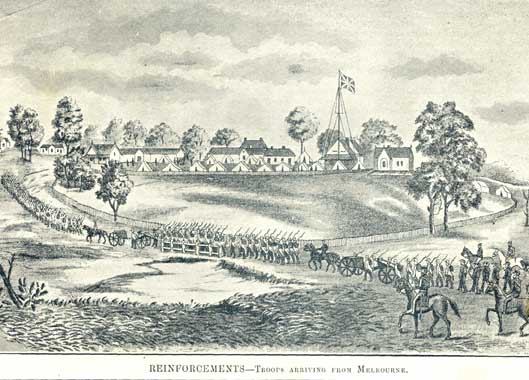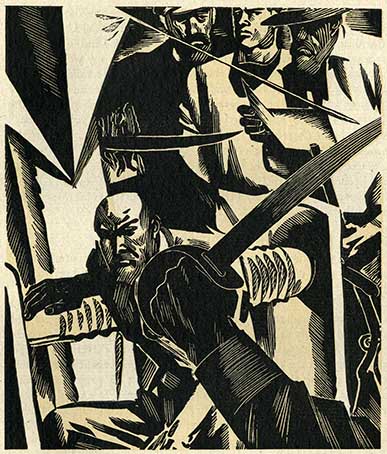John Hill Birch
Contents
Background
John Hill Birch and his twin brother James Birch were born on 5 July 1833 and baptised two days later at the First Presbyterian Church in Dungannon, County Tyrone, Northern Ireland. They were the first-born children of Samuel Birch and Emily (nee Hill), who were married in Belfast in August 1829. All that is known about their families is that Samuel’s father, James, was a farmer in Castledawson when Samuel enrolled in the Belfast Academical Institution (Belfast College) in 1824. After graduating in 1828, Samuel established an academy in Dungannon, which he ran as Master during the 1830s. Various family documents later refer to him as a Doctor of Laws and a Presbyterian Minister, but these titles are fabrications. His death is unrecorded, but he may have died in Dungannon between 1846 and 1851. By 1852, Emily and their six children had moved to Belfast, where she supported them by teaching. She was also closer to her own family, one of the Hill families of Carnmoney, near Belfast. No record of her birth can be found, but her parents were probably John and Margaret (nee McConnell) and she had at least five younger siblings. [1]
The Birch twins trained as brass-founders in Belfast, before enlisting as privates in the 12th (Suffolk) Regiment of the British Army in April 1853. By then, James had married Mary Ann Stewart at St Anne’s church, Belfast, on 25th December 1852, and had fathered a son, Charles Stewart. Both John and James understated their ages by about three years in order to receive the £4 bonus for being under 18. In July 1854, they sailed from Cork, in a complement of 330 officers and men, 41 women and 37 children, aboard the Camperdown. The ship arrived in Port Phillip Bay, Melbourne, on 17 October and promptly ran aground at Queenscliff. However it floated free and berthed at Queens Wharf, Melbourne, the next day.[2]
Goldfields Involvement, 1854
On Saturday 24 October 1854, Private John Hill Birch (#3242) was amongst a detachment of 86 rank-and-file troops of the 12th Regiment that set off at dawn and marched to Ballarat. They were to reinforce the troops and police at Ballarat in the lead-up to the miners’ rebellion that would reach its climax in the Eureka Stockade on 03 December 1854. It’s not known if John Hill Birch was amongst the 65 bayonet-bearing troops from the 12th Regiment that took part in the storming of the stockade, but he would have been involved in some way and well aware of the consequences.[3]
Post 1854 Experiences
After things quietened down, John Hill Birch was amongst those troops left on duty in Ballarat, but on January 12th 1855 he deserted, along with five other soldiers from his regiment. In the Victoria Police Gazette of 26th January 1855, John was described as 22 years and 6 months old, 5 foot 6 inches high, with fair complexion, brown hair and grey eyes. It also noted that he was wearing his regimental coat and hat at the time he absconded.[4]
From then on, there are only vague reports of John Hill Birch for the next 45 years. Tracking him is complicated by the existence of a number of men with this name. For example, in July 1857, a man was charged in the Ballarat Police Court with feloniously entering the tent of a digger named John Birch in the early hours of the morning. There was also a newspaper report of an assault carried out on a John Birch, at Guildford in April 1860, by a man named Dawson, but without more details it cannot be confirmed that either of these cases involve John Hill Birch of the 12th Regiment. [5]
Perhaps most confusing of all, there was another Private John Birch (#3311) in the 12th regiment on board the Camperdown in 1854. Formerly a painter from Herefordshire, he was in a small detachment posted to Castlemaine early in 1855. In September 1855 he was arrested and charged with ‘robbery in company’, after he and two women had forcibly stolen a watch and chain and several pound notes from a miner named Aaron Garlick at a sly-grog tent at Barkers Creek. This John Birch was found guilty and sentenced to 18 months hard labour on the roads, with the women receiving three months in Castlemaine gaol. Muster rolls for the 12th regiment show that he was ‘in custody of civil power’ during 1856, but he must eventually have returned to duty, as he was posted to New Zealand in 1860, along with Private James Birch, and seems to have been just as big a troublemaker.[6]
In 1864, a John Birch was a storekeeper and miner in Marong, on the outskirts of Bendigo, but there are considerable doubts that he is the right man. If it was him, his luck had changed for the worse by November the following year, when a John Birch was charged in the Ballarat District Court with desertion from the 12th Regiment. It seems he had given himself up to police on the night of Friday November 24th because he was destitute and had nothing to eat. According to a court report in The Argus of 27 November 1865, John produced an army discharge document in the name of Malony to defend himself, but was remanded for a week in the Ballarat Gaol so his story could be investigated. His record of admission to the gaol on November 25th shows that, rather than ‘Malony’ as the newspaper had reported, he used the alias of ‘John Donohue’, the name of a shipmate on the Camperdown and fellow private in the 12th Regiment, who had enlisted in Cork in March 1853. Said Donohue was also sent to Ballarat, but in the contingent which marched in late November 1854 and was attacked by miners at the Eureka diggings. John Birch also falsely gave his birth place as Galway and his religion as Roman Catholic, but his physical description tallies with that supplied in the notice of his desertion in 1855, with the added information that he weighed nine stone 12 lbs and was stout, and had ‘heavy brows, high cheekbones, thick lips and a long nose’. The record also notes ‘D on left’, indicating that he must have been charged earlier with being a deserter and had the letter D tattooed under his left arm, the practice of the time in the British Army. John was discharged on December 2nd, presumably into the custody of the court, which proceeded to remand him for a further week for the same reason, the seeking of more evidence. On December 2, Superintendent Nicholson of Ballarat wrote to the Chief Commissioner of Police and received a reply written two days later. All that is recorded of the correspondence is that the Commissioner stated that “Deserter Donoughue (sic) — discharge is genuine”. This is odd, because there is a record that Donohue deserted in Sydney in March 1864, so how the Commissioner could come up with his response in inexplicable. However, it appears to have been sufficient explanation for Superintendent Nicholson, because the gaol record shows that John Birch was discharged on December 5th and the final outcome of his case is not known. No record can be found of when he was arrested and branded as a deserter; in any event, desertion was abolished as a crime in 1871.[7]
By 1878 John Hill Birch was free and still in the Ballarat area, as he was admitted to the Ballarat Base Hospital between the 9th and 15th of December for an undisclosed illness. Two more admissions to the Ballarat Hospital took place when he was in the Carngham – Snake Valley district, firstly between 12th and 24th May 1880, and then again between the 25th April and 10th May 1881. He was an inpatient at the Creswick Hospital, near Ballarat, from 12th July until 22nd August 1880, when his residence was given as Long Point. He was admitted with ‘hydatids of the liver’, a common illness at the time in Victoria, and was discharged seven weeks later. It’s likely that he was readmitted for another three weeks in May–June 1881, only a week or so after his discharge from Ballarat hospital; although the record states he was English, everything else matches well, even his residence of ‘Ascot’, which was close to Long Point on the western edge of the Creswick Goldfield. This time his condition was given as ‘pleurodynia’, a painful inflammation of the lungs, so he was clearly suffering from very poor health.[8]
There are also records of a John Birch being admitted on several occasions to the Bendigo Hospital, firstly on April 5th, 1870, when the patient was living in Eaglehawk. Suffering hepatitis, he was admitted on the recommendation of the Eaglehawk Council, and was discharged a few weeks later, on the 25th April. It’s likely that this John Birch was the former store owner in Marong. The next admission record however fits our John Hill Birch much better, as his residence was given as Carngham when he was admitted on July 25th, 1883, on the recommendation of a local Protestant clergyman. Alcoholism was the stated reason for his admission and he was said to be ‘cured’ on discharge a week or so later on August 3rd. He was readmitted to the Bendigo Hospital on December 27th 1895, suffering partial paralysis, and was referred to the Benevolent Asylum on December 31st. The hospital records show he had ‘no fixed address’ but the asylum records show his previous address as Milloo, a small settlement on the plains north of Bendigo. Upon his release on 24th April 1896 he went to live with ‘friends at Kamarooka, where he would be looked after.’ He was readmitted to hospital on 1st July the same year suffering urinary incontinence and was again, for the last time, referred to the Bendigo Asylum a week later. It seems John spent his last few years at the asylum, as he died there on 19th July 1900 of senile debility. He was buried on July 21st in a pauper’s grave in the White Hills Cemetery (Interment No. 014070). The exact site is not recorded, although it is within the Present Graves area, probably in either sections A3 or A4, but it is not possible to find these.[9]
There is no evidence for John Hill Birch ever marrying, so there are no family records or anecdotes to hint at what role he played, if any, at Eureka. As he died a pauper, he left nothing. But there’s no doubt he could have told many stories about the rebellion, his life on the Victorian goldfields and how he’d survived.[10]
See also
Further Reading
Corfield, J.,Wickham, D., & Gervasoni, C. The Eureka Encyclopaedia, Ballarat Heritage Services, 2004.
References
- ↑ Birch, Bill, John Hill Birch: Eureka veteran, unpublished research emailed to Eurekapedia, 01 April 2013.
- ↑ Birch, Bill, John Hill Birch: Eureka veteran, unpublished research emailed to Eurekapedia, 01 April 2013.
- ↑ Birch, Bill, John Hill Birch: Eureka veteran, unpublished research emailed to Eurekapedia, 01 April 2013.
- ↑ Birch, Bill, John Hill Birch: Eureka veteran, unpublished research emailed to Eurekapedia, 01 April 2013.
- ↑ Birch, Bill, John Hill Birch: Eureka veteran, unpublished research emailed to Eurekapedia, 01 April 2013.
- ↑ Birch, Bill, John Hill Birch: Eureka veteran, unpublished research emailed to Eurekapedia, 02 April 2013.
- ↑ Birch, Bill, John Hill Birch: Eureka veteran, unpublished research emailed to Eurekapedia, 01 April 2013.
- ↑ Birch, Bill, John Hill Birch: Eureka veteran, unpublished research emailed to Eurekapedia, 01 April 2013.
- ↑ Birch, Bill, John Hill Birch: Eureka veteran, unpublished research emailed to Eurekapedia, 01 April 2013.
- ↑ Birch, Bill, John Hill Birch: Eureka veteran, unpublished research emailed to Eurekapedia, 01 April 2013.
External links
http://www.ballaratgenealogy.org.au/art/12th_regt_list.htm

